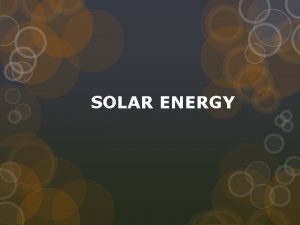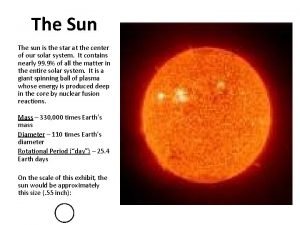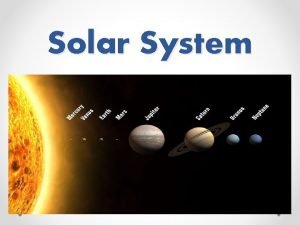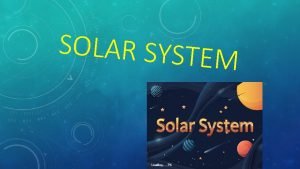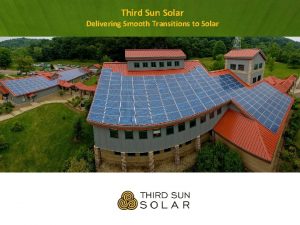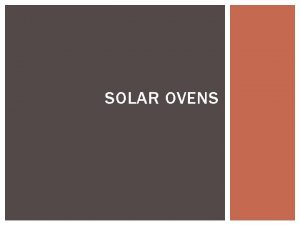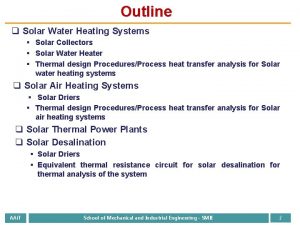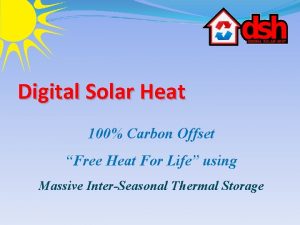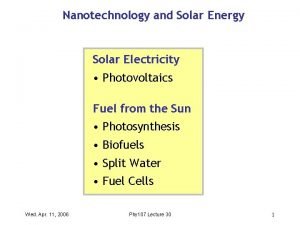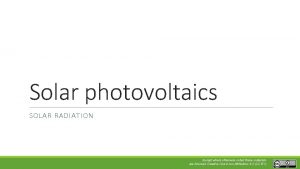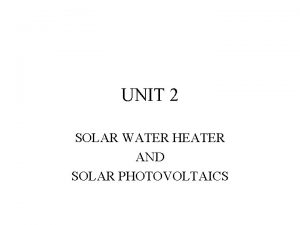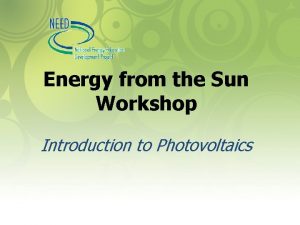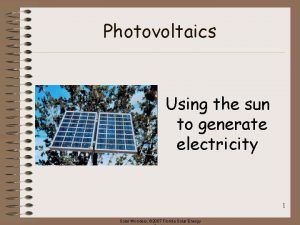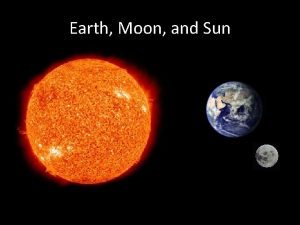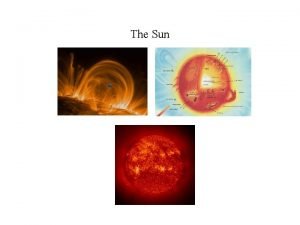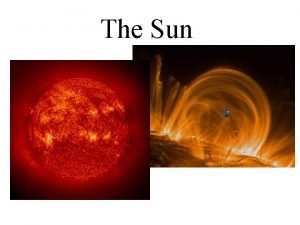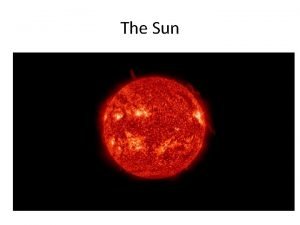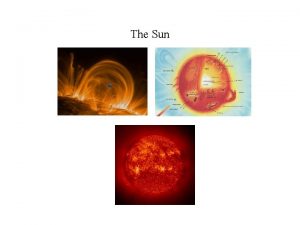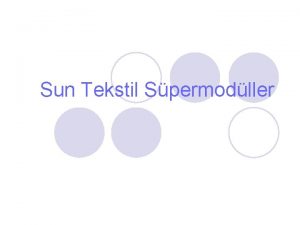Solar Photovoltaics Heat from the sun Kw or


























- Slides: 26

Solar Photovoltaics


Heat from the sun

Kw or MW possible

Physics of Photovoltaic Generation n-type semiconductor + + + + - - - - - Depletion Zone p-type semiconductor

Photovoltaic System Typical output of a module (~30 cells) is ≈ 15 V, with 1. 5 A current

PV Technology Classification Silicon Crystalline Technology Thin Film Technology Mono Crystalline PV Cells Amorphous Silicon PV Cells Multi Crystalline PV Cells Poly Crystalline PV Cells ( Non-Silicon based)

Silicon Crystalline Technology § § Currently makes up 86% of PV market Very stable with module efficiencies 10 -16% Mono crystalline PV Cells Multi Crystalline PV Cells • Made using saw-cut from single • Caste from ingot of melted • Operating efficiency up to 15% • Cell efficiency ~12% cylindrical crystal of Si and recrystallised silicon • Accounts for 90% of crystalline Si market

Thin Film Technology § § Silicon deposited in a continuous on a base material such as glass, metal or polymers Thin-film crystalline solar cell consists of layers about 10μm thick compared with 200 -300μm layers for crystalline silicon cells PROS • Low cost substrate and fabrication process CONS • Not very stable

Amorphous Silicon PV Cells § The most advanced of thin film technologies § Operating efficiency ~6% § Makes up about 13% of PV market PROS • Mature manufacturing technologies available CONS • Initial 20 -40% loss in efficiency

Poly Crystalline PV Cells Non – Silicon Based Technology Copper Indium Diselinide § CIS with band gap 1 e. V, high absorption coefficient 105 cm-1 High efficiency levels § PROS • 18% laboratory efficiency • >11% module efficiency CONS • Immature manufacturing process • Slow vacuum process

Poly Crystalline PV Cells Non – Silicon Based Technology Cadmium Telluride ( Cd. Te) § Unlike most other II/IV material Cd. Te exhibits direct band gap of 1. 4 e. V and high absorption coefficient PROS • 16% laboratory efficiency • 6 -9% module efficiency CONS • Immature manufacturing process

Semiconductor Material Efficiencies

Emerging Technologies ‘ Discovering new realms of Photovoltaic Technologies ‘ § § § Electrochemical solar cells have their active component in liquid phase Dye sensitizers are used to absorb light and create electron -hole pairs in nanocrystalline titanium dioxide semiconductor layer Cell efficiency ~ 7% Electrochemical solar cells

Emerging Technologies Ultra Thin Wafer Solar Cells § § Thickness ~ 45μm Cell Efficiency as high as 20. 3% Anti- Reflection Coating § Low cost deposition techniques use a metalorganic titanium or tantanum mixed with suitable organic additives

Environmental Aspects § § Exhaustion of raw materials CO 2 emission during fabrication process Acidification Disposal problems of hazardous semiconductor material In spite of all these environmental concerns, Solar Photovoltaic is one of the cleanest form of energy

PV’nomics • PV unit : Price per peak watt (Wp) ( Peak watt is the amount of power output a PV module produces at Standard Test Conditions (STC) of a module operating temperature of 25°C in full noontime sunshine (irradiance) of 1, 000 Watts per square meter ) A typical 1 k. Wp System produces approximately 1600 -2000 k. Wh energy in India and Australia • • A typical 2000 watt peak (2 KWp) solar energy system costing $8000 (including installation) will correspond to a price of $4/Wp

Payback Time • Energy Payback Time: EPBT is the time necessary for a photovoltaic panel to generate the energy equivalent to that used to produce it. A ratio of total energy used to manufacture a PV module to average daily energy of a PV system. At present the Energy payback time for PV systems is in the range 8 to 11 years, compared with typical system lifetimes of around 30 years. About 60% of the embodied energy is due to the silicon wafers. •

Solar PV Costs 1980 -2000 There has been almost six fold decline in price per peak watt of PV module from 1980 to year 2000

Solar electricity prices are today, around 30 cents/k. Wh, but still 2 -5 times average Residential electricity tariffs

PV’nomics …. § § § Module costs typically represents only 40 -60% of total PV system cost and the rest is accounted by inverter, PV array support, electrical cabling and installation Most PV solar technologies rely on semiconductor-grade crystalline-silicon wafers, which are expensive to produce compared with other energy sources The high initial cost of the equipment they require discourages their large-scale commercialization

‘ The basic commercialization problem PV technology has faced for 20 years : markets will explode when module costs decline, but module costs can't decline much, until the market grows much larger ‘ -PV Insider's Report

The Other Side • Use newer and cheaper materials like amorphous silicon , Cu. In. Se 2 , Cd. Te. • Thin-film solar cells use less than 1% of the raw material (silicon) compared to wafer based solar cells, leading to a significant price drop per k. Wh. • Incentives may bring down the cost of solar energy down to 10 -12 cents per kilowatt hour - which can imply a payback of 5 to 7 years.

However …. • If a location is not currently connected to the “grid”, it is less expensive to install PV panels than to either extend the grid or set up small-scale electricity production. • PV : Best suited for remote site applications having moderate/small power requirements consuming applications even where the grid is in existence. • Isolated mountaintops and other rural areas are ideal for standalone PV systems where maintenance and power accessibility makes PV the ideal technology.

Applications • • • Water Pumping: PV powered pumping systems are excellent , simple , reliable – life 20 yrs Commercial Lighting: PV powered lighting systems are reliable and low cost alternative. Security, billboard sign, area, and outdoor lighting are all viable applications for PV Consumer electronics: Solar powered watches, calculators, and cameras are all everyday applications for PV technologies. Telecommunications Residential Power: A residence located more than a mile from the electric grid can install a PV system more inexpensively than extending the electric grid (Over 500, 000 homes worldwide use PV power as their only source of electricity)

Building Integrated systems § § § These systems use the existing grid as a back up, as the PV output falls or the load rises to the point where the PV's can no longer supply enough power PV arrays can form an attractive facing on buildings and costs are equivalent to certain traditional facing materials such as marble with the advantage of generating free electricity. Ideal for situations where peak electricity demand is during daytime such as commercial buildings.
 Solar energy is radiant light and heat from the sun
Solar energy is radiant light and heat from the sun Wholesale panel solar cell
Wholesale panel solar cell What is an inexhaustible source of energy
What is an inexhaustible source of energy Uranus distance from sun
Uranus distance from sun Dual sun solar system
Dual sun solar system Star sun solar
Star sun solar Assurant springfield oh
Assurant springfield oh Heat trap solar
Heat trap solar Solar heat exchanger
Solar heat exchanger Digital solar heat
Digital solar heat Latent heat absorbed or released
Latent heat absorbed or released Dry heat cooking methods examples
Dry heat cooking methods examples Specific heat capacity
Specific heat capacity Bổ thể
Bổ thể Từ ngữ thể hiện lòng nhân hậu
Từ ngữ thể hiện lòng nhân hậu Diễn thế sinh thái là
Diễn thế sinh thái là Tư thế ngồi viết
Tư thế ngồi viết Ng-html
Ng-html Giọng cùng tên là
Giọng cùng tên là Phép trừ bù
Phép trừ bù Bài hát chúa yêu trần thế alleluia
Bài hát chúa yêu trần thế alleluia Hổ sinh sản vào mùa nào
Hổ sinh sản vào mùa nào đại từ thay thế
đại từ thay thế Vẽ hình chiếu vuông góc của vật thể sau
Vẽ hình chiếu vuông góc của vật thể sau Công của trọng lực
Công của trọng lực Tỉ lệ cơ thể trẻ em
Tỉ lệ cơ thể trẻ em Thế nào là mạng điện lắp đặt kiểu nổi
Thế nào là mạng điện lắp đặt kiểu nổi
